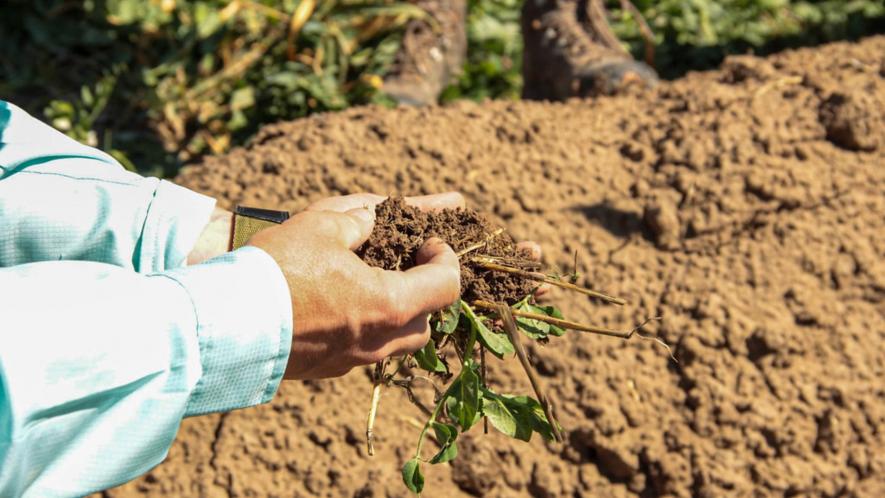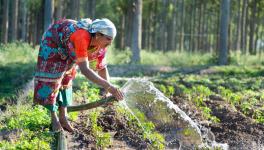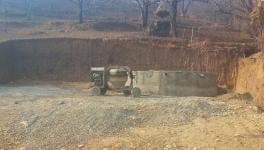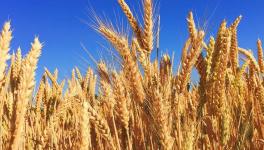Carbon Farming: Sustainable Farming Technique That Keeps Soil Healthy, Combats Climate Change

Representational Image. Image Courtesy: Flickr
What if there were a way to safely pull billions of tonnes of carbon out of the atmosphere to substantially reduce or even eliminate global warming?
What if this approach costs relatively little and could be used around the world?
What if it also put billions of dollars in cash into the hands of countless working Americans and people worldwide?
What if it even slashed fossil fuel consumption and made the world more resilient to climate stress?
Well, it turns out there is a system that can do all that. It’s called carbon farming, and it just might be key to restabilising the climate. In the process, it can revitalise rural economies while also producing healthier, more nutritious crops. And amazingly, it’s also low-cost, low-tech, and low-risk.
The carbon farmer works with simple inputs: land, seed, compost, moisture, sometimes animals and manure, and sometimes specially selected microorganisms that speed a depleted soil’s return to health.
Carbon farming doesn’t pull land out of production or abuse natural ecosystems. It’s a “down-to-earth” solution to global warming that employs nature’s omnipresent carbon cycle, which constantly shuttles carbon molecules into and out of the atmosphere, soil, fresh water, and ocean. Yet carbon farming is still neither widely known nor widely practiced.
A School of Hard Knocks
In well-worn jeans and a plaid shirt, Gabe Brown looks like the North Dakota farmer-rancher he is. But if you were to assume that Brown practices typical US production agriculture, you would be wrong. Brown has an iron will, a deep religious faith, a tremendous capacity for hard work, and “a calling” to bring hope to struggling farmers and ranchers while providing healthful food to consumers. Unlike most farmers, though, he’s not as concerned with yields per acre or dollars per pound as he is with soil health.
How soil became “top of mind” for Brown—and how he became a rock star of regenerative agriculture—is a tale of good tidings for the climate, the planet, and agriculture in the United States.
Early in his farming career, Brown endured modern-day trials of Job. In 1995, he wasn’t much different from many farmers he knew: a young man with a new family, a struggling farm, and a sizable operating loan to service. That year, a hailstorm wiped out 1,200 acres of his spring wheat the day before he was to start harvesting it. Because hail had been uncommon and mild during the previous 35 years, Brown had no hail insurance and was financially devastated.
The bank stuck with him, though, and loaned him more money—but, once again, the following year, hail destroyed his entire crop. At that point, the bank refused to provide a similar new loan.
Brown had to figure out how to ranch and farm without all the expensive chemical fertilisers, herbicides, pesticides, and genetically modified (GMO) seeds on which neighbouring farmers and ranchers depended, and which he now had no money to purchase.
In those days, no one baled the grass in the roadside ditches into hay for cattle because of the garbage and rocks found there. “It was a pain to do,” Brown recalled. But his ranch was relatively small, and he could no longer afford to buy forage for his cattle. So, he went from neighbour to neighbour and asked if he could put the hay in their ditches.
“They just laughed and said, ‘Sure.’” “I would mow it and rake it and bale it. Then I’d carry those small square bales out of that ditch [and] onto the road. At night, my wife would drive with the kids in the car seats with a flatbed trailer behind, and I’d throw those bales onto that trailer one at a time. They probably averaged about 70 or 75 pounds, and I remember years we did 7,000 of them. … That’s a lot of steps up and down a road ditch.”
The next year, 1997, was extremely dry. Brown and his wife Shelly were just able to scrape enough feed together to keep the cattle, but once again, he had no crop income. “So, you just keep digging a bigger hole because we had land payments to make,” he explained.
The next June, another hailstorm cost Brown 80% of his crop.
Those four years, Brown said, “were hell to go through. I wouldn’t wish it on anybody, but in the end, it was the best thing that could have happened because it forced me to change my mindset. … I realized, ‘I have to look at my whole operation… from the eyes of nature and how nature functions.’”
Refocusing on the Synergies of Nature
During the years of hail and drought, Brown had often wondered how the 2,000 acres of unplowed native prairie on his land could grow so much forage naturally every year without synthetic inputs. It always had live roots, was always protected by vegetation that sealed in the moisture, and was extraordinarily rich in species.
To figure this out, Brown went to his local public library. There, he read the journals Thomas Jefferson had kept about agricultural practices on his plantation at Monticello, Virginia, where Jefferson planted turnips and vetches to improve degraded soil. Brown also read the journals of Meriwether Lewis and William Clark, who had wintered at native Mandan villages in North Dakota—just north of Brown’s ranch—in the early 19th century. The Mandans planted “the three sisters”—corn, beans, and squash—along with tobacco. They were focusing on the synergies of nature, said Brown. They got a legume, a grass, and the squash plant “all working in harmony to benefit each other.” He took note.
Brown also noticed that when the third hailstorm pounded his crops onto the ground, it armoured his thirsty soil, sealing in its moisture against drought. This was important because his ranch has no irrigation and gets only 10 to 12 inches of rainfall a year, plus another 5 inches of moisture from melted snow. (It snows there every month except July.)
Informed by his new knowledge of Mandan agriculture, Brown decided to try planting legumes and grass, cover crops that would thrive synergistically through the residue of the hail-killed crops. He intended to raise feed for his livestock and add organic matter to the soil. Then, not even having money to buy the twine to bale hay, Brown simply let his livestock graze off the cover crops. The livestock got a free meal, and their manure enriched the soil. “That started the act of livestock integration on cropland.”
Carbon-Friendly Agriculture
Through his efforts to survive and keep his farm, Brown gained crucial insights into how ecosystems function and the importance of livestock to maintaining a healthy soil ecosystem. Surmounting the challenges this presented forced him to create a new, “carbon-friendly” agriculture that was as economical, as creative, and unconventional.
At a time when many family farms were succumbing to competition from industrial agriculture, Brown was able to avert bankruptcy by throwing out the prevailing business model. Instead of the soil-depleting, additive-heavy, financially draining agricultural practices he had learned in vocational school, his farming techniques mimic nature, heeding soil biology and integrating profitable enterprises in an agrarian ecosystem in which little is wasted; the byproducts of one operation are cleverly used as the inputs or feedstock of another.
As a result, the more than 130 different products sold by Brown’s Ranch include organic, grass-fed beef and lamb, pastured pork and pigs, poultry, honey, fruit, and heirloom vegetables in season, as well as border collies. “Don’t tell me there’s no money in production agriculture!” he said. “There’s a myriad of opportunities.”
These days, instead of baling grass in ditches at night, Gabe Brown is on the road most of the year to consult and lead regenerative agriculture workshops through the nonprofit Soil Health Academy, where he is a partner. “I really believe that my purpose is to give people hope. … By that, I mean farmers and ranchers and now, more so, consumers. … We’re trying to regenerate everything, including climate.”
What Makes Soil Ecosystems ‘Tick’
To understand what Gabe Brown is up to, one has to understand how soil ecosystems operate: they run on carbon, the same way fuel powers an engine. Carbon-rich organic matter gives rich, fertile soils their dark colour and clumpy texture and nourishes soil organisms and plants. Carbon-poor soil is less able to support life, producing lower crop yields, less forage, and less biodiversity. Soil health is like a magic elixir for climate health.
Brown’s new approach to farming was not initially aimed at mitigating climate change. He simply noticed that the cover crops he grew, when his fields otherwise would have been fallow, significantly raised the soil’s water-holding ability and put more live roots into it year-round, as on the native prairie; when those cover crops died, their roots decomposed and increased the soil’s organic matter content, nourishing other plants and soil organisms.
So, the organic matter Brown added to nourish his crops and livestock also had the unsought benefit of boosting the soil’s carbon concentration. (Organic matter is more than 50% carbon.) Even in harsh, dry North Dakota—where it’s sometimes -40 degrees Fahrenheit in winter—Brown’s agricultural techniques have captured vast amounts of valuable carbon. And that carbon, removed from the air and packed away in the soil, provides climate benefits.
Sequestering Carbon in the Soil
Brown’s Ranch was the subject of a soil survey operation designed by John M. Norman, an environmental biophysicist at the University of Wisconsin-Madison. Norman analysed the carbon and nitrogen in the ranch’s top 4 feet of soil. An early measurement he made in 2017 indicated that those horizons contained an extraordinary amount of carbon per acre (92 tonnes), but the preliminary estimate was never confirmed, despite some follow-up measurements in 2018 and 2019, due to the project’s premature termination. “The amount of carbon he’s sequestered in this soil is staggering,” Norman told me at the time. Even digging 4 feet below the surface wasn’t deep enough for Norman to record all the extra carbon.
Moreover, he said, “The deeper you bury the carbon, the longer it’s going to be in there.” That’s important for climate stability because if the carbon moves back into the air right away, it hasn’t been purged from the atmosphere for the long term. “[Gabe] built a remarkable soil in a couple of decades. … A wise farmer,” Norman concluded, “can grow soil a lot faster than Mother Nature.”
To further increase his soil’s organic matter, Brown nowadays inoculates his seeds with mycorrhizal fungi, and he plants a diverse mix of cover crops to keep the soil from overheating in the summer as the plants capture carbon from the air. Mycorrhizal fungi form a relationship with the roots of vascular plants and are critically important to the development of soil structure, fertility, and water-holding capacity; they also aid plants in using soil nutrients and resisting disease. By promoting plant growth and health, they help increase soil organic matter. “Nature is more collaborative than competitive,” Brown believes.
‘Mob-Grazing’ Pasture
Ultimately, Brown’s cover crops are incorporated into the soil after frost kill and decomposition or when Brown “mob-grazes” a pasture. That’s when cattle trample much of the forage into the soil, protecting it against wind and water erosion and helping it to insulate the ground from temperature extremes, thereby improving warm-weather water retention.
“The hotter it gets, the less water is available for plant growth,” Brown said. “At 70 degrees, 100 percent of the water is available for plant growth. At 100 degrees, only 15 percent is used for growth, and 85 percent is used for evaporation. At 130 degrees, 100 percent of water evaporates; at 140 degrees, soil bacteria die.”
“[Soil] structure is built by a living system of microorganisms—little animals and the roots of the plants,” Norman said. “They basically make a house for themselves and maintain that structure under a condition that’s high yield for the whole system.”
Conventional Versus Regenerative Agriculture
Conventional farmers are addicted to fertilizers, pesticides, and herbicides. They see nature as more competitive than cooperative, so they try to remove or poison anything they see competing with their crops—thereby killing beneficial insects and soil life, including the helpful fungi. In addition, conventional farmers often leave the ground bare in the spring, allowing the soil to erode under rushing snowmelt water and pounding rains that can seal its surface, increasing runoff and decreasing water storage.
By contrast, in Brown’s regenerative agricultural system, plant residues are left on the ground to decompose, and tiny organisms come up to the soil surface. “They increase the infiltration rate by a huge factor,” Norman said. This is important not only for allowing adequate moisture to soak in to carry plants through dry spells but also for farmers and ranchers trying to adapt to climate change.
As the climate gets warmer and the frequency and severity of flooding increases, permeable soil is more important than ever to absorb the heavier rainfall. “Gabe Brown’s soil can take a foot of water in an hour with no runoff,” Norman reported. “That’s unheard of in a conventionally tilled agricultural soil.”
John J. Berger is an environmental science and policy specialist, prize-winning author, and journalist. His latest book is Solving the Climate Crisis: Frontlines Reports from the Race to Save the Earth (Seven Stories Press, 2023). He is a contributor to the Observatory.
SOURCE: Independent Media Institute
CREDIT LINE: This adapted excerpt is from Solving the Climate Crisis: Frontline Reports From the Race to Save the Earth © 2023 by John J. Berger and is licensed under Creative Commons CC BY-NC-ND 4.0 by permission of Seven Stories Press. It was adapted and produced for the web by Earth | Food | Life, a project of the Independent Media Institute.
Get the latest reports & analysis with people's perspective on Protests, movements & deep analytical videos, discussions of the current affairs in your Telegram app. Subscribe to NewsClick's Telegram channel & get Real-Time updates on stories, as they get published on our website.
























